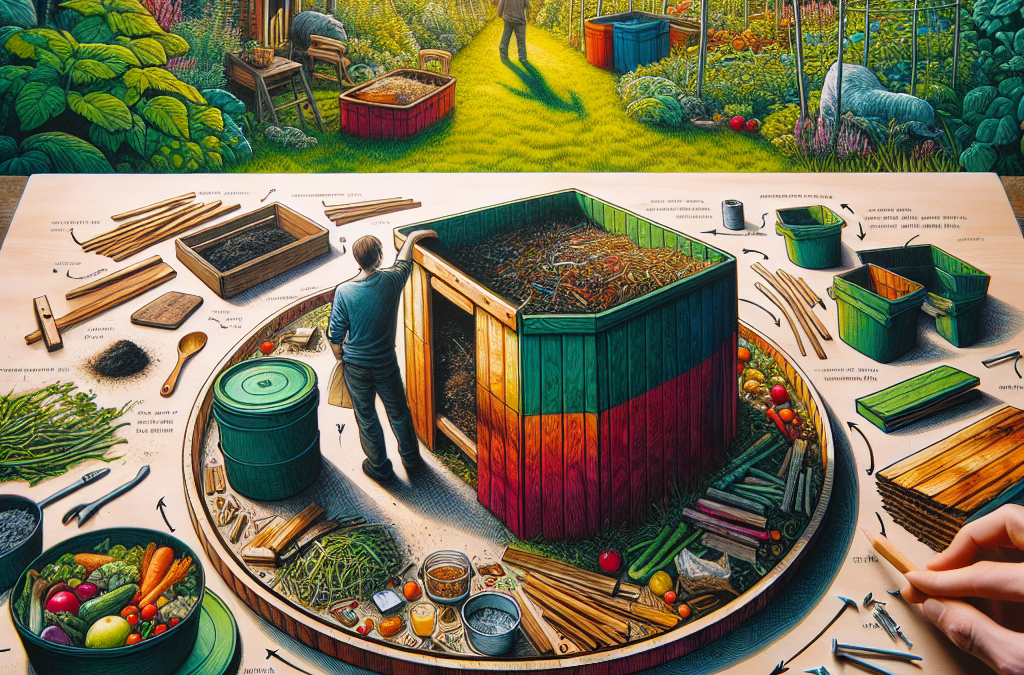Choosing the Right Location for Your Compost Bin
Assessing Your Yard
A great compost bin starts with picking the right spot. When I first set up my compost bin, I had to think about sunlight and shade. Ideally, you want a location that’s partially shaded. Full sun can dry out your compost too quickly. A spot near your garden is also a bonus; it makes it easier to throw scraps right into the bin!
Next, consider accessibility. You’ll want to check if you can get to it easily all year round. If it’s too far from your kitchen or garden, you might end up letting those scraps pile up instead of making compost.
Lastly, watch out for drainage! You don’t want your compost bin sitting in a puddle whenever it rains. After several trials, I found a slightly elevated and dry spot that works perfectly and makes sure my compost stays wet but not soggy.
Choosing Materials for Your Compost Bin
Types of Containers
So, let’s dive into what kind of container you want. I’ve used a few different things over the years—wooden pallets, old bins, and even store-bought compost tumblers. Wooden pallets are a great start if you’re looking to save some cash, but make sure they’re untreated to avoid chemicals.
If you want to invest a bit, compost tumblers are amazing! They make mixing easy and can speed up the process. Each type has its perks, so consider how much you want to spend and how much work you’re up for.
Oh, and don’t forget about DIY! There are stacks of plans online to build your own compost bin. I personally love the satisfaction of building something myself. It’s like crafting but for gardening!
What to Compost and What Not to Compost
Green vs. Brown Materials
This is where it gets really fun! “Green” materials—think kitchen scraps like fruits and veggies—are great for nitrogen. “Brown” materials—like dried leaves and cardboard—provide carbon. I usually aim for a ratio of about 2:1, with more brown than green. Trust me, it makes a difference!
But also, be careful about what you add. For example, avoid dairy, meat, and oils. They attract pests faster than you can say “compost!” I learned this the hard way when I ended up with a funky smell that wafted through my yard.
It’s also good to rinse out any big pieces that don’t break down. Just last week, I found a big old onion peel that was still hanging around. I pulled it out and tossed it in my worm bin instead!
How to Maintain Your Compost Bin
Turning Your Compost
To keep the breakdown happening, you’ll need to turn your compost every now and then. I usually use a pitchfork for it, which is a game-changer! Once a week or every other week is my go-to. It helps aerate the pile, and trust me, your nose will thank you.
And remember, don’t be shy! If it’s looking too dry, add a bit of water or more green materials. On the flip side, if it’s too wet, toss in some brown materials to balance it out. I once let mine get too soggy and learned to check it more regularly.
After about 3-6 months, you’ll see dark, crumbly goodness forming. It’s like magic! You’ll want to get your hands in there and feel the rich soil that was once your kitchen scraps.
Using Your Compost in the Garden
When to Use Your Finished Compost
Once you’ve got that rich, dark compost, it’s time to put it to use! I like to use it to enrich my garden soil in spring before planting. It’s like a nutrient boost that your plants will love.
You can also sprinkle some on top of your garden beds during the growing season. The plants will absorb the nutrients as it rains or you water them. It’s like giving them a little gift from the earth!
Don’t be afraid to experiment with compost tea, too! Just steep some finished compost in water, strain it, and use that for watering your plants. It’s a great way to ensure they get a little extra love!
Frequently Asked Questions
1. How long does it take for compost to be ready?
The process can take anywhere from 3 to 6 months, depending on how often you turn it and the materials you use. Regular attention will speed things up!
2. What should I do if my compost smells bad?
If it’s emitting a foul odor, it’s likely too wet or has too many greens. Fix it by adding dry materials like shredded paper or dried leaves and turning it to aerate.
3. Can I compost meat and dairy?
It’s best to avoid composting meat and dairy; they attract pests and can create a huge mess. Stick with fruits, veggies, and plant materials for the best results.
4. Should I use soil in my compost bin?
No need to add soil! It could introduce weeds or pests. Just focus on balancing your green and brown materials to create a healthy environment for the microbes to do their job!
5. Can I add sick plants to my compost bin?
It’s better to avoid adding sick plants to your compost. They can spread pathogens that might make your compost unhealthy. Dispose of them in a way that won’t spread the issue.





